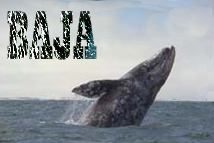

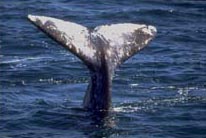
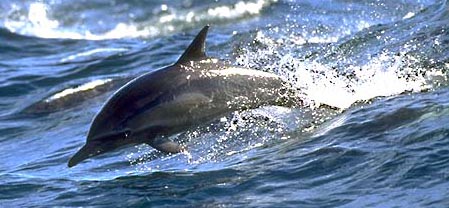
We are enveloped in blackness and we are silent. In the distance, in every direction we hear the explosive 'whooosh' of blowing gray whales surfacing in the lagoon. Above, a pollution free sky glows like a celestial cityscape, mirrored by the bioluminescence of innumerable sea creatures shifting in the swells around our boat. It was a quiet moment, a special moment of tranquility, shattered a moment later as a gray whale spy-hopped beside us, rising like 'Jaws' out of the darkness within yards of our group and scaring all of us half to death! Welcome to the Baja!
The Gulf of California is home to one of the largest populations
of whales and dolphins in the world, with at least six species
of great whales and several species of dolphins regularly spotted.
It is, of course, most famous for the wintering population of
Gray Whales, many of which gather at San Ignacio Lagoon to give
birth before beginning their northbound migration along the west
coast to their arctic feeding grounds.
The focus of our trip is to visit with and to photograph the Gray
Whales, although we're likely to see and to photograph several
other Cetaceans as well. On our last trip several years ago we
had a wonderful view of two BLUE WHALES, the largest animal ever
to have existed on this planet. For nearly forty-five minutes
the whales floated nearby and when they finally swam off we followed,
capturing their thirty-foot wide flukes when the whales dove deep.
One evening, as we anchored for the night, a pod of killer whales
(Orcas) appeared, slowly swimming about only a few hundred yards
away. We hauled anchor and sailed out, and within minutes we were
among the whales.
The next hour or so were among the most magical we've had with
wild animals. The pod circled around our boat, dipping beneath
and surfacing on either side, with individuals sometimes turning
on their side to pause, obviously watching us as they did so.
While I'm sure I'm only projecting my feelings of 'oneness' here,
we all had that feeling, one of mutual curiosity and harmlessness.
As stupid as this may sound, I was sorely tempted to just slip
off the boat and to swim among the whales, but fortunately caution
(or common sense) overrode that urge, as Orcas could mistake me
for one very pale seal! This anecdote, however, illustrates my
point -- the Baja, the whales, are magical, and the experience
of encountering and interacting with the whales is more than simply
special.
Interaction is, indeed, a reality, as you may discover when a
female Gray Whale purposefully pushes its calf towards your panga
(an outboard-powered skiff). As incredible as it may seem, whales
often swim up to and investigate a panga, and females will often
bring their babies up close as if introducing their young. Sometimes,
over-enthusiastic whales will actually swim beneath a boat and
slowly rise, gently lifting their cargo (the folks in the skiff!)
out of the water. I've never been in a skiff where that has happened,
and I'll pass on that if I have the choice, but it happens and
the experience, though scary, is exhilarating and benign.
One has to ask why do Gray Whales do this? An animal that was
nearly hunted to extinction less than 80 years ago exhibits a
curiosity; one could say a friendliness, that completely contradicts
the very negative experience Gray's have had at the hand of man.
Gives one a sense of hope!
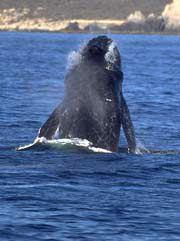 Mysticism almost seems to be a
theme. On another night we were treated by a 'light show' when
a sea lion appeared and began to play around our boat. It would
dive and jump and streak through the water, with its progress
completely unseen to our eyes if it were not for the bioluminescent
trail its path stirred up. Like a living comet the seal would
race past us, creating a wave of turbulence of glowing green microorganisms.
Like kids at a great fireworks display, all of us spontaneously
'oohed' and 'aaahhhed' and clapped as the seal went through its
routine. Neat, you might say, but what was so mystic about this?
We hadn't even seen a seal in this area earlier in the day or
on the following day. Our seal appeared, gave its show, seemingly
responding to our applause, and disappeared. Truly, a gift of
nature.
Mysticism almost seems to be a
theme. On another night we were treated by a 'light show' when
a sea lion appeared and began to play around our boat. It would
dive and jump and streak through the water, with its progress
completely unseen to our eyes if it were not for the bioluminescent
trail its path stirred up. Like a living comet the seal would
race past us, creating a wave of turbulence of glowing green microorganisms.
Like kids at a great fireworks display, all of us spontaneously
'oohed' and 'aaahhhed' and clapped as the seal went through its
routine. Neat, you might say, but what was so mystic about this?
We hadn't even seen a seal in this area earlier in the day or
on the following day. Our seal appeared, gave its show, seemingly
responding to our applause, and disappeared. Truly, a gift of
nature.
Humpback whales winter off Cabo San Lucas and we're usually lucky
enough to encounter a few. Males are prone to breach at this time
of year, the breeding season, and it is thought that this explosive
demonstration of raw power serves as an advertisement for the
health and vigor of the male.
Fin whales, the second largest species, sometimes appear but most
views of these are fleeting. Fins rarely breach or spy-hop, but
instead just sail passed, the nuclear-powered submarine of the
whale world, the fastest swimmer of the fleet.
 Our
journey will begin in San Diego and we'll cruise along the western
coast of the Baja Peninsula, stopping en route at San Benito Island
where herds of enormous Elephant Seals haul up on the beaches
to rest. Males, with huge, pendulous noses they can inflate into
a swollen trunk, may rise like giant sandworms (a Dune analogy
here) as they jostle each other to establish or maintain a dominance
order. Unlike areas in the United States where Elephant Seals
haul out, San Benito's seals are often within yards of fishing
shacks and getting close, for intimate photography, is not an
issue. Safety is, and we'll be careful!
Our
journey will begin in San Diego and we'll cruise along the western
coast of the Baja Peninsula, stopping en route at San Benito Island
where herds of enormous Elephant Seals haul up on the beaches
to rest. Males, with huge, pendulous noses they can inflate into
a swollen trunk, may rise like giant sandworms (a Dune analogy
here) as they jostle each other to establish or maintain a dominance
order. Unlike areas in the United States where Elephant Seals
haul out, San Benito's seals are often within yards of fishing
shacks and getting close, for intimate photography, is not an
issue. Safety is, and we'll be careful!
One of the absolute highlights of every Baja trip is our encounter
with the Bottlenose and Common Dolphin. Dolphins regularly ride
the bow waves generated by a fast moving boat, and our boat captain,
Captain Art Taylor, absolutely loves this. At times we've had
schools of several HUNDRED dolphins swimming in tandem with our
boat, riding the waves and leaping out of the water. It is incredibly
exciting, and, in the past, it was a real film burner. Today,
with digital, we can only imagine how many frames we'll be firing
since the capture rate on jumping dolphins is always incredibly
low and disappointing. But it can be done with film -- we've proven
that, it's just that we're now looking forward to blasting off
images on digital.
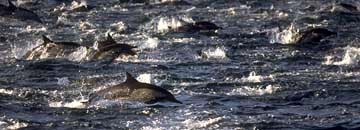 Truly one of the most spectacular
events we've ever witnessed was a huge school of Common Dolphins
swimming en masse, skimming in repetitive leaps that made each
dolphin resemble a skipping stone across the sea. Hundreds, if
not thousands, of Dolphins were churning the sea. Images from
this encounter have been published in several places by a number
of photographers on our boat, including one that was a runner-up
in the BBC Wildlife Photographer of the Year Competition.
Truly one of the most spectacular
events we've ever witnessed was a huge school of Common Dolphins
swimming en masse, skimming in repetitive leaps that made each
dolphin resemble a skipping stone across the sea. Hundreds, if
not thousands, of Dolphins were churning the sea. Images from
this encounter have been published in several places by a number
of photographers on our boat, including one that was a runner-up
in the BBC Wildlife Photographer of the Year Competition.
Although we'll have an opportunity to snorkel in several places,
on one of the last days of our journey we'll have a chance to
snorkel at Los Islotes, a California Sea Lion area. Typically
we'll have seals swimming about us, zooming in at incredible speeds
on a dead-on, crash collision course, only to veer off at the
last instant in an arching swoop. If seals laugh, they're doing
so, for it is both scary at times and exhilarating. It's always
fun.
Fun, and magical. Have you heard of the Green Flash? You'll see
it if you don't blink, when at the exact moment the sun dips beneath
the horizon the light rays refract in a way that creates a momentary
flash of green light. It is subtle and fleeting, and visible only
where one has a chance to see the sun set behind the earth's curvature
in pristine atmospheric conditions. Of course, the trip is also
photographically productive. Unlike our whale trips to Alaska
where we may cruise for days before we strike gold and catch Humpback
Whales bubble-net feeding, the Baja generally offers something
great every day. We'll explore several islands on foot, photographing
cactus, lizards, and birds, and we'll have a chance at some real
quality shooting of pelicans, frigatebirds, gulls, and, if we're
lucky, nesting ospreys.
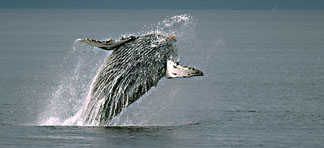
The trip is limited to 24 people on a boat that can easily sleep 30. If you're interested, inquire ASAP!
If you own a digital camera you will be especially interested
in our BONUS and FREE Digital Workshop that we will informally
conduct in our 'free' moments. If you do not shoot digital, you
might be interested in sitting in and learning what digital is
all about. Of course, both FILM and digital shooters are welcome
and expected on this trip, but we figured this would be the perfect
time and place to help all the digital shooters along. As any
film shooter knows, digital photographers have issues!
Whale cruises provide plenty of downtime while sailing or at anchor
in the evening and we'll maximize that time to provide you with
the basic skills to maximize your digital potential. We'll cover
all the basic workflow issues -- importation, creating files,
backing up, and organization, and the even more important image
editing. We'll be demonstrating one of the most powerful programs
for Image Editing and Processing of RAW captured files-- Capture
1, as well as Adobe Photoshop CS's RAW conversion program.
Whale and dolphin photography, and the world of digital imaging,
go hand-in-hand in a perfect match. Peak moments when a whale
spy-hops or fleeting instantaneous opportunities as a dolphin
breaks a wave crest to leap into the air, these times and more
are potential 'film' burners, and what better way to inexpensively
blast through images than with digital? You'll learn the importance
and versatility of shooting in a RAW format and basic image enhancements
via Photoshop. Shooting on water often produces canted, sloping
horizons, and we'll show you a quick, simple remedy for correcting
and leveling those horizons! Tweaking color, increasing saturation,
removing unwanted distractions, getting rid of dust, and sharpening
an image -- you'll maximize your digital images and you'll learn
how.
 You'll
need to have your own laptop computer and an image processing
software program (we recommend Photoshop CS), and if you shoot
RAW, you might wish to obtain
You'll
need to have your own laptop computer and an image processing
software program (we recommend Photoshop CS), and if you shoot
RAW, you might wish to obtain
Capture 1's RAW conversion
program. Free trial downloads are usually offered.
Day 1: San Diego
Travel to San Diego. You will be responsible for getting yourself
to the harbor at Fisherman's Landing no later than 7PM. We will
board our boat, the Searcher at Fisherman's Landing, and be assembled
by 8:00pm for a passenger orientation delivered by the crew and
captain of the Searcher. Depart 11:00pm, as we set sail for the
south.
Day 2: Islas Todos Santos
This is a sailing day with stops at Ensanada harbor to clear Mexican
Customs and Immigration. We'll be cruising along the Todos Santos
islands to view nesting seabirds, rocky reef and cliff life, and
harbor seal adults and pups. Throughout, we'll be whale watching
for migrating gray whales, dolphins, and seabirds aboard the
Searcher. This is the area we're most likely to have Pacific white-side
dolphins swimming with us, and there's always a chance of hunting
Orcas in the area.
Day 3. Islas San Benito
 One
of the trip highlights, San Benito is home to a huge colony of
Northern Elephant Seals. Once very much in danger of extinction,
the Elephant Seal has returned en force and virtually every cove
and beach has seals. Amazingly, for such a large animal (males
can reach over fifteen feet), it's actually easy to overlook and
almost trip over a seal sleeping on the beach! We're quite likely
to photograph seals fighting dominance bouts, as well as getting
close to resting cows and pups. For those with the energy there
will be an opportunity to hike to an old lighthouse where, on
the sea stacks en route, ospreys often nest. We'll observe nesting
birds, such as osprey and ravens, and enjoy unique desert plants.
One
of the trip highlights, San Benito is home to a huge colony of
Northern Elephant Seals. Once very much in danger of extinction,
the Elephant Seal has returned en force and virtually every cove
and beach has seals. Amazingly, for such a large animal (males
can reach over fifteen feet), it's actually easy to overlook and
almost trip over a seal sleeping on the beach! We're quite likely
to photograph seals fighting dominance bouts, as well as getting
close to resting cows and pups. For those with the energy there
will be an opportunity to hike to an old lighthouse where, on
the sea stacks en route, ospreys often nest. We'll observe nesting
birds, such as osprey and ravens, and enjoy unique desert plants.
Day 4-5: Laguna San Ignacio
We'll be spending two days at the most famous and productive lagoon
for Gray Whales, Laguna San Ignacio. Whale watching and photography
is done from small skiffs, called pangas, which gives us near
water-level viewpoints. This is the area where we may have adults
investigating our pangas, and mothers with young. It is quite
likely that one or more whales will come close enough that you'll
actually touch, or pet, their rubbery skin as they swim by. Or
you may be showered by 'whale breathe' when one exhales from its
blow hole, covering us with a fine mist. Whales, by the way, could
use breath mints!
Spy-hopping, where a whale rises vertically out of the water like
a Polaris missile to investigate its surroundings before slipping
back beneath the sea, and breaching, where adults make huge leaps,
are two activities we usually have luck with in San Ignacio. And,
of course, we'll be on the lookout for babies!
We'll also have time to explore the area's pristine beaches for
macro shots of shells and surf-polished stones, blooming plants,
and tidal animals and to observe feeding birds in the mangrove
channels.
Day 6: Offshore Bahía Magdalena
We'll spend the day cruising the Pacific around the mouth of Magdalena
Bay where marine mammals can be especially common. We'll have
a chance at observing and photographing blue and humpback whales,
herds of common dolphins, and pelagic seabirds with the rugged
peninsula as a truly scenic backdrop for photography
Day 7: Cabo San Lucas & Los Frailes
The Land's End rock formations can be spectacular, as the orange-red
rock glows on fire in early morning light. Frigatebirds and pelicans
circle the formation in the thermals, creating an almost prehistoric
atmosphere. Afterwards, we'll cruise to the Gorda Banks where
humpback whales gather. Humpback whales are very acrobatic - spectacular
to observe, photograph, and listen to with our underwater microphone.
We won't be seeing bubble-net feeding -- that's a summer activity
off the coast of Alaska, but we may photograph adults as they
breach. Later in the day we'll go ashore at Los Frailes to walk
along a beautiful beach and bird watch.
Day 8: Isla San José
Our boat, the Searcher, will arrive at the spectacular red sandstone
cliffs of Punta Colorado for photographing at sunrise. On a typical
day -- a clear day, the quality of the light is incredible as
the rocks catch the first sunrays clearing the earth's curvature.
We'll take a skiff ride into a cave and along the cliffs for up-close
views of nesting brown and blue-footed boobies, pelicans, yellow-footed
gulls, osprey and white-throated swifts. Afterwards we'll take
a desert plant and bird walk through an arroyo formed by the scenic
red cliffs. Wide-angle and macro possibilities abound, as the
cliffs remind one of a flooded Zion -- a particularly odd combination!
As the day heats up and we finish our photography we can enjoy
snorkeling to observe the tropical fish in the reefs and the sandy
coves. For the afternoon, we'll have plenty of time to whale watch
for blue, fin and sperm whales, as well as the large pods of bottlenose
dolphin that frequent this area.
Day 9: Isla Santa Catalina
This island is famous for the 12-foot "wavy" barrel
cactus and the saguaro-like cardon cactus and other desert plants
that grow along the canyon, where an early morning walk is an
enjoyable option. Birdlife is abundant and we should see and hear
cardinals, Gila woodpeckers, ravens, and verdin. Other famous
residents include the rare endemic Santa Catalina rattleless rattlesnake
and the abundant emerald-tailed lizards. This particular rattlesnake
is the only species that lacks a rattle, but otherwise, in every
way it is a rattlesnake and a member of the Crotalus genus. I've
yet to see one, but I'm hoping to! There will be snorkeling opportunities
at this island, where the shallow reefs are home to many species
of fish, sea stars, sea fans, and more marine life. Again we'll
spend time aboard the Searcher for the afternoon whale watching
in this productive area.
Day 10: Nopoló and Islas Los Islotes
In the early morning we'll do some photography and bird watching
at one of the Baja's best locations of Nopoló. Later, we'll
travel to Los Islotes, two islets with underwater rocky reefs
that are used by sea lions as haul-out sites. We'll do skiff rides
around the islets to obtain great views of the sea lions, fishes
and invertebrates along the reefs, as well as nesting boobies
and other birds. For the adventurous, you'll be able to dive in
for some great snorkeling among the sea lions!
Day 11: Cabo San Lucas
This is our departure day. We'll disembark the Searcher in Cabo
San Lucas at 8:00am. Vans are available for transport to Los Cabos
(also called San Jose del Cabo) airport for return flight connections
to the U.S. or for a downtown hotel stay in Cabo. Any stay in
Cabo San Lucas will be on your own.
Itineraries and schedules subject to change based on weather conditions, captain's discretion, and the uncertainties operating within foreign preserve guidelines.
A quote from Art Taylor, the Searcher's owner/operator: "I've found that there's a common misconception about our late March trips to Baja: many people fear that the whales will be gone. I'm happy to say that that's never been the case! Sure, some of the adult gray whales have left the lagoons to begin their northward migration, but hundreds of mothers and calves remain, and these more mature calves are among the most inquisitive that we've seen. Plus, we see tons (literally!) of other toothed and baleen whale species, which are quite common in Baja this time of year. Another plus for late March trips: we get the benefit of some great weather and warmer water for snorkeling. My advice: don't limit your Baja calendar to our early trips. Late spring in Baja is fantastic!" Art Taylor and Celia Condit
Trip includes:
· All food and beverages (including beer and wine) on the
boat, from breakfast on day 1 to breakfast on day 11
· Mexican tourist Visas
Trips does not include:
· Transportation to dock in San Diego
· Flights from Cabo San Lucas back to the States
· T-shirts and other sale items purchased aboard the Searcher
· · A fuel surcharge will be imposed on the charter price only if there is a substantial rise in the cost of fuel. The amount will be determined at the time of departure. As we all know, gasoline and diesel fuel prices have risen significantly in the last few months. While we do not anticipate a surcharge, one could be levied and this will be added to your trip cost at the time of departure and payable at that time.
Trip Requirements:
· Proof of citizenship, a valid passport, is required
of each passenger.
· Each participant must sign a Acknowledgement of Risk
and Release of Liability form for both McDonald Wildlife Photography
and Searcher Natural History Tours prior to joining the tour.
A deposit of $1500 is required at time of registration. Due to the upfront costs of this trip, $500 of the deposit is non-refundable.
Trip Costs:
Cost of the trip is $2975.00 based on a minimum of 18 participants, double-occupancy.
Cost of trip for 15 - 17 registered participants: $3525.00
Cost of trip for 18 - 24 registered participants: $2975.00
Final payment due: November 11, 2004 - 120 days prior to start of trip
Due to the nature of today's travel atmosphere, with the uncertainty of terrorist attacks, rising fuel costs or a sudden crash in the travel industry, we strongly recommend purchasing trip cancellation insurance. An insurance application will be included with the acknowledgement letter to all registrants. Please note, if for any reason, at any time, we have to cancel this trip due to unforeseen terrorist threats and the subsequent lack of registrants, the following cancellation policy applies.
Cancellation policy:
120 days or more before your departure: $500 Cancellation
fee.
91-119 days before departure: $500 Cancellation fee, plus
$500 for fees charged by suppliers providing services included
in your tour.
61-90 days before departure: $500 cancellation fee, plus
$1,250 for fees charged by suppliers providing services included
in your tour.
60 days or less before departure:
No Refunds Available.